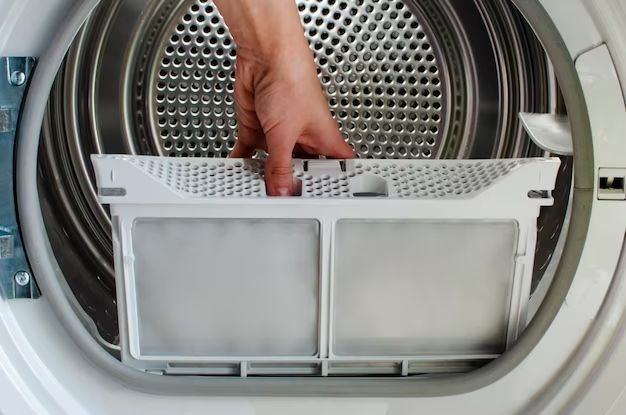Washing machines come in many different styles and configurations, from basic top-loading models to high-end front-loading ones. With so many options on the market, one common question consumers have is whether any washing machines come with built-in lint filters.
Page Contents
The purpose of a lint filter
A lint filter serves an important purpose in catching and trapping lint during the wash cycle. Lint consists of small fibers and particles of fabric that get detached from clothes over time. If lint is allowed to circulate freely in the wash water, it can end up redepositing back onto clothes. This leads to pilling and lint buildup on garments over repetitive wash cycles.
A lint filter catches this lint so that it does not recirculate back onto clothes. Lint filters are commonly found in clothes dryers, where a great deal of lint generation occurs as wet fabrics tumble and rub against each other. However, lint can also be generated during the washing cycle, so a washing machine lint filter helps manage lint right from the start.
Washing machine designs and lint filtration
Many top-loading washing machines do not come with a dedicated lint filter. Top-loaders wash clothes in an agitating motion, with clothes churning continuously in wash water. This agitation dislodges lint from fabrics, suspending it in the water.
In most top-loaders, lint removal happens through the drain outlet. Top-loaders drain wash water via a tube that draws water from underneath the wash basket. Lint particles get carried along with the water out to the drain. Some degree of lint filtration also happens as wash water passes through small holes in the wash basket during the drain cycle.
Because top-loaders rely largely on draining to remove lint, using a lint-catching bag or filter on your drain outlet is recommended. This provides extra lint trapping since the machine itself does not have a filter.
In contrast, most front-loading washing machines do come equipped with a lint filter. Front-loaders wash clothes by tumbling them through wash water, rather than agitating. The wash basket spins one way, then reverses direction repeatedly. This tumbling motion is gentler on fabrics than agitation.
However, since clothes are not churning constantly in water, lint tends to collect in one place rather than circulating freely in the tub. That’s why front-loaders benefit from a lint filter, usually located at the bottom of the wash basket or behind a small access door.
Should you clean the lint filter regularly?
On front-load washers with lint filters, cleaning the filter regularly is recommended for optimal performance. Lint should be removed from the filter after each wash cycle. Over time, lint accumulation in the filter can lead to the following problems:
- Reduced water flow and water pressure for washing clothes
- Longer drain times after the wash cycle
- Odors starting to develop from mold and bacteria buildup
- Lint redepositing onto clothes, creating pilling and fuzz
Make lint filter cleaning part of your routine washing machine maintenance. Use the following steps to clean the lint filter:
- Locate the lint filter inside the washing machine. It is usually found at the bottom of the wash basket or behind a small, removable access panel.
- Pull out the lint filter. It may lift out or slide out depending on model.
- Remove any lint accumulation. For minor buildup, simply wiping the filter clean with a tissue or paper towel will suffice. For heavier buildup, use warm water and mild detergent to break up lint and residue.
- Allow the lint filter to dry completely before replacing. Do not reinsert when wet.
- Replace the cleaned lint filter securely in its housing.
- Run an empty wash cycle to flush out any loosened lint in the machine.
Repeat these steps after every 1-2 wash loads to prevent lint filter clogging over time. A clean lint filter is key for optimal washing performance.
Examples of washing machines with lint filters
While top-loaders generally lack a lint filter, many front-load washing machine models do come equipped with this handy feature. Here are a few examples:
| Brand | Model | Lint Filter Details |
|---|---|---|
| LG | WM3700HWA | Mesh lint filter behind access door |
| Samsung | WF45R6300AV | Self-cleaning filter behind access panel |
| Electrolux | EFLS627UTT | Slide-out mesh filter |
| Maytag | MHW8630HW | Removable lint filter at bottom of tub |
| Whirlpool | WFC8090GX | Lint filter along outer rim of tub |
These are just a few examples of front-load washer models that come with a dedicated lint filtration system. Check the product details closely when shopping for a new washing machine to determine if a lint filter is included.
Conclusion
In summary, top-loading washing machines generally rely on draining wash water to remove lint, rather than using a built-in lint filter. However, many front-load washing machines do come equipped with reusable lint filters, usually located behind an access door or at the bottom of the wash basket.
Cleaning the lint filter regularly is important on front-loaders to prevent lint buildup from impairing washing ability and redepositing back onto clothes. Consider lint filtration as a key factor when shopping for a new washing machine.
